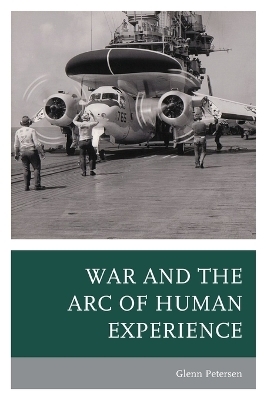
War and the Arc of Human Experience
Seiten
2021
Hamilton Books (Verlag)
978-0-7618-7235-1 (ISBN)
Hamilton Books (Verlag)
978-0-7618-7235-1 (ISBN)
In this book, an anthropologist sets his experiences as a teenager fighting in the Vietnam War within the larger sweep of American culture and society. When his daughter is born decades after he returned from war the violence of those experiences, long suppressed, emerges from the shadows.
Glenn Petersen flew seventy combat missions in Vietnam when he was nineteen, launching from an aircraft carrier in the Tonkin Gulf. He’d sought out the weighty responsibilities and hazardous work. But why? What did the cultural architecture of the society he grew up in have to do with the way he went to war? In this book he looks at the war from an anthropological perspective because that’s how he’s made his living in all the subsequent years: it’s how he sees the world. While anthropologists write about the military and war these days, they do so from the perspective of researchers. What makes this a fully original contribution is that Petersen brings to the page the classic methodology of ethnographers, participant observation—a kind of total immersion. He writes from the dual perspectives of an insider and a researcher and seeks in the specifics of lived experience some larger conclusions about humans’ social lives in general. Petersen was long oblivious to what had happened to him in Vietnam and he fears that young men and women who’ve been fighting the US military’s wars in Afghanistan and Iraq might be similarly unaware of what’s happened to them. Skills that allowed him to survive in combat, in particular his ability to focus tightly on the challenges directly in front of him, seemed to transfer well to life after war. The same intensity led him to a successful academic career, including the time he represented the Micronesian islands at the United Nations; how could anything be wrong? Then surreptitiously, the danger, the stress, and the trauma he’d hidden away broke through a brittle shell and the war came spilling out. As an anthropologist he sees in this a classic pattern: an adaptation to one set of conditions is put to a new and practical use when conditions change, but in time what had once been beneficial turns into maladaptive behavior. In writing about why we fight, he shed lights on what the fighting does to us.
Glenn Petersen flew seventy combat missions in Vietnam when he was nineteen, launching from an aircraft carrier in the Tonkin Gulf. He’d sought out the weighty responsibilities and hazardous work. But why? What did the cultural architecture of the society he grew up in have to do with the way he went to war? In this book he looks at the war from an anthropological perspective because that’s how he’s made his living in all the subsequent years: it’s how he sees the world. While anthropologists write about the military and war these days, they do so from the perspective of researchers. What makes this a fully original contribution is that Petersen brings to the page the classic methodology of ethnographers, participant observation—a kind of total immersion. He writes from the dual perspectives of an insider and a researcher and seeks in the specifics of lived experience some larger conclusions about humans’ social lives in general. Petersen was long oblivious to what had happened to him in Vietnam and he fears that young men and women who’ve been fighting the US military’s wars in Afghanistan and Iraq might be similarly unaware of what’s happened to them. Skills that allowed him to survive in combat, in particular his ability to focus tightly on the challenges directly in front of him, seemed to transfer well to life after war. The same intensity led him to a successful academic career, including the time he represented the Micronesian islands at the United Nations; how could anything be wrong? Then surreptitiously, the danger, the stress, and the trauma he’d hidden away broke through a brittle shell and the war came spilling out. As an anthropologist he sees in this a classic pattern: an adaptation to one set of conditions is put to a new and practical use when conditions change, but in time what had once been beneficial turns into maladaptive behavior. In writing about why we fight, he shed lights on what the fighting does to us.
Glenn Petersen is professor at the City University of New York’s Baruch College and Graduate Center.
List of Figures
Introduction
Chapter One Why We Fight
Chapter TwoBecoming a Warrior
Chapter ThreeEveryday Danger
Chapter FourStress and Decompression
Chapter FiveThinking I’ve Left War
Chapter SixDaddy, Daddy, Daddy!
Chapter SevenWar and the Arc of Human Experience
Chapter EightEveryday War
Chapter NineWhy We Fought
AppendixSERE, Torture, Psychologists, and the CIA
Glossary
References
Index
About the Author
| Erscheinungsdatum | 05.05.2021 |
|---|---|
| Verlagsort | Lanham, MD |
| Sprache | englisch |
| Maße | 153 x 230 mm |
| Gewicht | 481 g |
| Themenwelt | Literatur ► Biografien / Erfahrungsberichte |
| Sachbuch/Ratgeber ► Geschichte / Politik | |
| Sozialwissenschaften ► Soziologie | |
| ISBN-10 | 0-7618-7235-3 / 0761872353 |
| ISBN-13 | 978-0-7618-7235-1 / 9780761872351 |
| Zustand | Neuware |
| Haben Sie eine Frage zum Produkt? |
Mehr entdecken
aus dem Bereich
aus dem Bereich
Caspar David Friedrichs Reise durch die Zeiten
Buch | Hardcover (2023)
S. Fischer (Verlag)
CHF 34,95
Geschichte, Positionen, Perspektiven
Buch | Softcover (2024)
C.H.Beck (Verlag)
CHF 16,80


